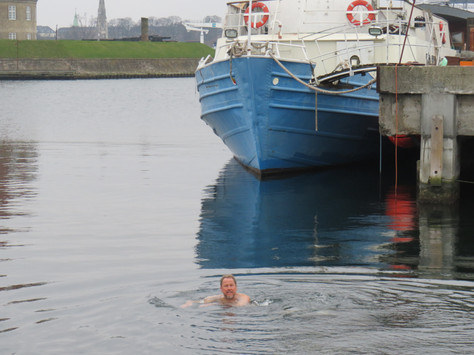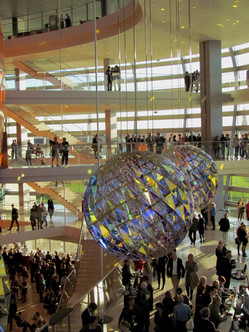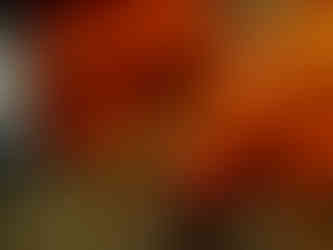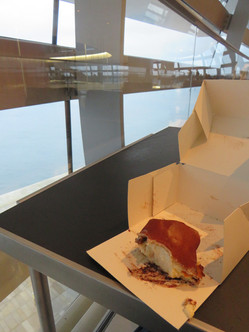65@65 SWIM #49 LA BANCHINA, COPENHAGEN
- LXVswim
- Mar 18, 2020
- 5 min read
Updated: Jun 30, 2024
La Banchina isn’t Italian, it is firmly Copenhagen in a cockle-shell. It is a café in a run-down shed on the canal front in a brown field site on the Northern stretch of the city, going out to a rapidly renovating urban waste-land. But it really isn’t a waste land, as there is so much mental and physical energy being used in creative and generative ways here, and La Banchina is a small and exciting part of it. The food is great – everything traditional tastes like it should, everything new makes something new happen in your mouth. The staff are intelligent and keep things simple. Ponytails, piercings and tattoos, tee-shirts and dry humour. Last year I came here for the first time every with the Serpentine Crew – Simone, Sarah, Susan, Anne and Shelley-Anne. We ordered our sauna as we arrived, and arranged our slot with the people changing at the bench there. Then to the café - the people serving there had a few laconic introductory comments – “you can’t swim in the canal, but as you see…” pointing to the jetty and the ladder down into the December water, where two naked men had just come out. Following up with “it’s against the law to swim naked, but as you see…” Then the food – hot buns covered in a light brushing of a spicy syrup, freshly picked tiny carrots from the nearby greenhouse (which is also tended by La Banchina) in an elderflower vinaigrette (the elderflowers picked last early Summer then frozen. This is the noma effect – it is not just the posh restaurants (of which there are many in Copenhagen) that are raising their game by making their cuisine more Nordic, the food innovators, mostly younger people, are to be found across the city, in the crevices that were grimy that become hipster, in brownfield sites where factory premises don’t just serve as artists’ studios and galleries, but places where urban food is being innovated. Last year, Simone had a field day at Torvhallern, trying everything food-like that he could, the rest of us trying to pull him away. Supper at our apartment that night was memorable, cosy, intimate, hygge. In the afternoon, we befriended people at the sauna, on the deck in front of La Banchina, and, dare I say it, had a very hygge time. The experience was hygge. We took hygge with us into the evening.
La Banchina is organic, biodynamic, locally sourced, farm to table, no meat, local fish, clean wine, sustainable so far as this is possible. Today at La Banchina I can’t find time for all the good the food has. Regrettably, I am by myself, in a hurry (shame on me), in need of a swim (pre-swim tension, hoping to make my stress past-tense). On a Sunday afternoon, the cafe has a line going out of the door. This short-cuts a couple of decisions – I won’t get to eat here this time (there is always next time, another reason to return). I won’t get into the sauna as there is a list of people waiting to get in. So it is down to just swimming. This is immediately relaxing, and enough for me – there is time enough for a short swim in the six degree water. I am by far the oldest person here, chatting as I change. Why am I in a hurry? I am off to the opera house to see Cosi fan Tutti. I am not sure how cool that is to say to hipster people (probably OK, but showing my age, if I am not showing it enough already), so hold off on that. So, I get changed outside with everyone else, climb down two levels of decking and into the soothing water. Immediately calm, I taste the sea water and it is not so salty as I expect sea water to be. On another previous trip, at Ribersborg, Malmo, Jeremy explained why sea water varies in salinity across the world. It made sense to me then, while I was in the water, but I quickly forgot. It did seem logical – who said ”I never remember what people say, only the emotion with which they say it?”
The Royal Danish Opera House is all that Sydney Opera House could have been, if it had been built half a century later. Both are on the water front, in an ikonic location; both had state of the art architecture; both have Danish architects. ’If I were ever to want to have an opera house built, I would find a Dane to do it’ I thought to myself. There is no risk of that. The Opera House in Copenhagen is a destination; you can take the river bus to it and from it. Getting there by boat makes going there an event. Today I was on bus, which stopped behind the House, and I among many was taking the Opera House by stealth, from behind, and from the side. The view across the canal is to the royal palace and the Marble Church, both landmarks. Into the opera house and all is marble and glass and wood, the auditorium being a huge wallnut in the core of the front half of the building. Staircases an walkways at each of the levels above the ground made this a place to see and be seen, the glass front and side declaring transparency to the world of the harbour, with naval ships to one side, to the world of royalty and the church to the front, and the world of commerce and industry looking down the canal from this the entry point to it. It was two thirty in the afternoon, thirty minutes ahead of a matinee performance. I bought a cup of tea and climbed the stairs to the top deck of the opera house, where I could look down on the people arriving, hear the hub-bub of anticipatory pre-performance conversation, and found myself a table to sit at. There were plenty of these, and I joined the small number of people who had brought their own food – pre-packed salads, sandwiches, cake. I had my own treasured cake with me, specially. A potato cake, so called because it looks ugly, like a large spud straight out of the ground, covered in brown dirt. This brown dirt is a dusting of cocoa powder. Beneath the dust is a layer of marzipan about three millimeters think – Danes love marzipan. Beneath the marzipan is the structure of the cake – a choux pastry ball about the size of a cricket ball, you could hold it in your hand, if it were not so dusty or if you didn’t care about keeping your clothes clean. Within the cricket ball was a rich vanilla custard. Just speaking it to you now, it doesn’t sound the likeliest combination, but like a lot of things Copenhagen, the unlikely works, and works astonishingly well. The potato cake is the food I really have to have on every trip to Copenhagen, as a defining aspect of the trip.That, and curried herrings, which is another unlikely unexpected delight – it really shouldn’t work as something you would eat, but... But that is another story. Today, at two thirty five, after taking five minutes to explain the Copenhagen potato cake to you, I have a pastry box, within which is a potato cake, which I have fifteen minutes to eat and appreciate, in one of the most stunning locations on the planet. Swimming and cake go together. Swimming in hipster Copenhagen, and potato cake, sqidging vanilla custard trough choux pastry, smearing cocoa powder from marzipan onto cream and cream into mouth and onto beard, was less a coming together than a marriage, one which will be consumated orally, messily, every time I come to Copenhagen. Thoughts of marriage put my in a good frame of mind for today’s opera, Mozart’s Cosi fan Tutte, as the bells for 'ten minutes to rmance start' ring and echo across the auditorium.






























Comments